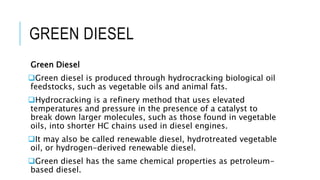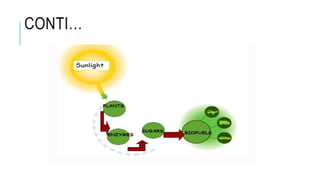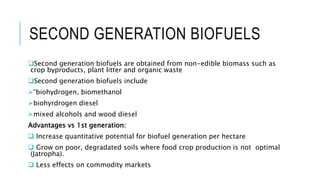Alishba 046.pptx
- 1. BIOFUEL TECHNOLOGY Alishba Khan
- 2. BIOFUEL TECHNOLOGY The term biofuel is referred to as liquid or gaseous fuels for the transport sector that are predominantly produced from biomass. The material of plants and animals, including their wastes and residues,is called biomass.
- 3. DIFFERENT SOURCES OF BIOFUEL Feedstock Sources Various sources of feeds tocks are described here. Algae oil Algae are single-celled organisms that, like plants, produce energy through the process of photosynthesis, Algae oil can be used to produce biodiesel. Extracting the oil leaves behind dried green flakes that can be further reprocessed to create ethanol, another fuel Carbohydrate (sugars) rich biomaterial It comes from the fermentation of starches derived from agricultural products like corn, sugar cane, wheat, beets, and other existing food crops, or from inedible cellulose.
- 4. CONTI… Oils rich biomaterial It comes from existing food crops like rapeseed (aka Canola), sunflower, corn, and others, after it has been used for other purposes, i.e food preparation Agriculture wastes (organic and inorganic sources) It comes from agricultural waste which is concentrated into charcoal-like biomass by heating it.
- 5. TYPES OF BIOFUELS Biodiesel Biodiesel is the most common biofuel in Europe. It is produced from oils or fats using transesterification and is a liquid similar in properties to fossil/mineral diesel Bioethers Bioethers are produced by the reaction of reactive iso-olefins, such as iso-butylene, with bioethanol. Bioethers are created from wheat or sugar beet They also enhance engine performance while significantly reducing engine wear and toxic exhaust emissions.
- 6. TYPES OF BIOFUEL Types of Biofuel Bioethanol Biomethanol Biogas Biodiesel
- 7. CONTI…. Biogas Biogas is methane produced by the process of anaerobic digestion of organic material by anaerobic bacteria. It can be produced either from biodegradable waste materials or by the use of energy crops fed into anaerobic digesters to supplement gas yields. Solid Biofuels Examples include wood, sawdust, grass trimmings, domestic refuse, charcoal, agricultural waste, nonfood energy crops, and dried manure.
- 8. GREEN DIESEL Green Diesel Green diesel is produced through hydrocracking biological oil feedstocks, such as vegetable oils and animal fats. Hydrocracking is a refinery method that uses elevated temperatures and pressure in the presence of a catalyst to break down larger molecules, such as those found in vegetable oils, into shorter HC chains used in diesel engines. It may also be called renewable diesel, hydrotreated vegetable oil, or hydrogen-derived renewable diesel. Green diesel has the same chemical properties as petroleum- based diesel.
- 9. SYNGAS Syngas Syngas, a mixture of CO, hydrogen, and other HCs, is produced by partial combustion of biomass, that is, combustion with an amount of oxygen (O2) that is not sufficient to convert the biomass completely to carbon dioxide (CO2) and water
- 10. CLASSIFICATION ACCORDING TO GENERATIONS •1st Generation •2nd Generation •3rd Generation Generations
- 11. CLASSIFICATION ACCORDING TO GENERATIONS Biofuel can be classified in to following types based on generations. First generation biofuels Derived from sugar, starch, and vegetable oil (only from edible parts of crops) – Two main types of 1st generation biofuels Bioethanol Made from sugar cane, corn Biodiesel Made from palm oil, rapeseed
- 12. CONTI… The starch from the basic feedstocks is fermented into bioethanol, or the vegetable oil through chemical process to biodiesel. First-generation feed stock This group mainly consists of maize, wheat, sugarcane, sugar beet, cassava, and corn These feedstocks are capable of being converted into biofuels (bioalcohols and biodiesel) by means of processes such as fermentation and transesterification, respectively
- 13. CONTI…
- 14. CONTI…. FIRST GENERATION BIOFUELS ARE: 1)BIO-DIESEL 2)GREEN-DIESEL 3)BIO-ETHERS 4)BIO-GAS 5)SYN-GAS
- 15. SECOND GENERATION BIOFUELS Second generation biofuels are obtained from non-edible biomass such as crop byproducts, plant litter and organic waste Second generation biofuels include “biohydrogen, biomethanol biohyrdrogen diesel mixed alcohols and wood diesel Advantages vs 1st generation: Increase quantitative potential for biofuel generation per hectare Grow on poor, degradated soils where food crop production is not optimal (Jatropha). Less effects on commodity markets
- 16. CONTI… Disadvantages: More of these species can be invasive and have negative impacts on water resources, biodiversity and agriculture At the moment they are still more expensive than fossil fuels Still under research and development for a significant commercial scale
- 17. THIRD GENERATION BIOFUELS The third generation biofuels come from algae, that are low-input, high-yield feedstock to produce Biofuels To produce third generation biofuels, such as biodiesel, butanol, gasoline, methane, bio-ethanol and jetfuel, biochemical and or thermochemical methods are employed Pros 30 - 100 times more energy productive and effective The Biomass leftover from oil pressing can be used for animal feeding and ethanol production Processing Biofuel from algae can capture large amount of CO2 They are relatively easy to grow, but the algal oil is hard and expensive to extract Cons High capital costs, early research stage
- 18. ENVIRONMENTAL BENEFITS Biofuels benefit environmental by reducing GHGs and reducing local pollution Bioethanolis water soluble, non toxic and biodegradable. Ethanol can replace 10% of the world’s gasoline without clearing more rain forests and by doing less harm to the environment than current agriculture Biofuels offer low levels of carbon dioxide emission. Biofuel by product is less dangerous to human health and the environment
- 19. ENVIRONMENTAL PROBLEMS biofuels, particularly those derived from palm biodiesel blends, may be more carcinogenic than conventional fuels. Fuels derived from biomass energy cannot be considered truly carbon‐ neutral because of the stages of production, transportation and proces sing require nonrenewable energy Studies have shown that fermentation and distilling of first generation biofuels create negative net energy. Limitations in Use in Vehicles - Some biofuels require modifications to vehicle engines and are still being used as additives instead of fossil fuel replacements. High Water Use - Those biofuel crops require large quantities are water to irrigate which may strain local or regional resources.
- 20. SOCIAL‐ECONOMICS BENEFIT •Reduce the price of oil cheaper ethanol reduces the demand of oil and the price of oil . Reduce fossil fuel imports– The use of ethanol can reduce the use of gasoline. A reduction in the use of gasoline reduces some of the depen dence on unstable foreign sources of oil. Reduce the poverty rate Most ethanol plants are in rural communities, and ethanol pro duction increases jobs due to plant construction, operations, a nd maintenance
- 21. CONTI…. Rise in farm land value High demand of corn leads to a rise in farm land values. Health benefits Health benefits from reduced global warming More efficient use than gasoline and protect vehicles Ethanol can help prevent engine knocking, and it increases gasolin e's lubricity. Low adoption cost Ethanol provides lower vehicle emissions without the need to purch ase a hybrid vehicle
- 22. CONTI…. Social‐Economics problems Increasing in water price – more water are used for crop and less for people, create water shortage . Soil Degradation With the increase in demand for alternative energy sources, demand for agricultural land could increase. Increase demand for biofuel derived from cash crops such as sugarcane, sugar beet, maze could result in major changes to current land use.





















